In the Moment:
Michael Frye's Landscape Photography Blog
by Michael Frye | Apr 14, 2019 | Night Photography
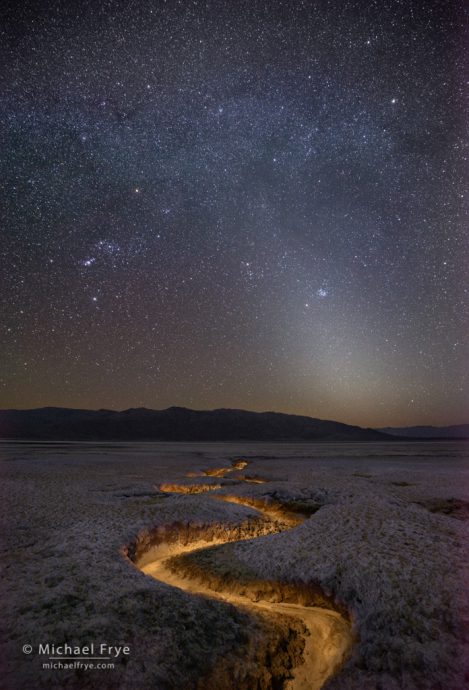
Stars, Orion, and zodiacal light over an eroded gully, Death Valley. Robert Eckhardt, Claudia, and I found this twisting gully while scouting for the workshop, and I thought it might line up well with Orion and the zodiacal light just after dark. It was actually Robert’s idea to light-paint the gully, though he didn’t join me on the night I photographed it. The focal length had to be very wide (16mm) in order to fit everything in the frame. I made eight exposures for the sky, each at 15 seconds, f/4, ISO 12,800, and blended those together with Starry Landscape Stacker. I made another longer exposure to record more detail in the landscape (4 minutes at f/4, ISO 6400). Then I captured four light-painting frames, adding a little light from the right and left, and tracing the gully with a flashlight as I walked beside it. All these images were blended together in Photoshop.
Death Valley has been used as the setting for many Hollywood movies. Not surprisingly, some of these films use the austere, other-worldly landscapes of Death Valley as a stand in for another planet. (This includes two titles from the original Star Wars series – Episode IV: A New Hope, and Episode VI: Return of the Jedi.)
This same other-worldly feeling works beautifully for night photography. I’ve made many nighttime images in Death Valley, and had a chance to capture a few more both before and during our recent workshop there. We had some challenging conditions at times, with wind, and plenty of clouds. But we also had one clear, calm night out in the dunes.
(more…)
by Michael Frye | Apr 10, 2019 | Travels and Stories
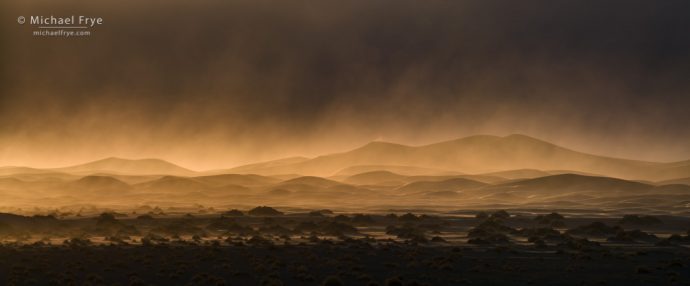
Sandstorm, Mesquite Flat Dunes, Death Valley NP, CA, USA
We tend to think of deserts as barren and desolate, but most deserts are actually full of vegetation. The plants may be widely spaced, but they’re abundant. Some desert areas, like Saguaro National Park, and Organ Pipe Cactus National Monument (both in Arizona), seem almost lush.
In Death Valley, however, there are miles and miles of bare, naked earth, without a scrap of vegetation. It’s austere, yet beautiful in its simplicity. The earth is laid out in plain sight, without any plants to obscure its colors, folds, and textures.
(more…)
by Michael Frye | Mar 17, 2019 | Travels and Stories
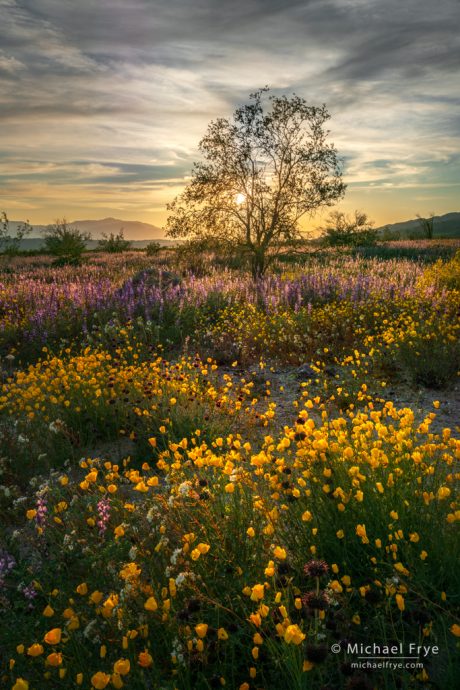
Desert in bloom at sunset, Joshua Tree NP, California. I bracketed three exposures, two stops apart, and blended them with Lightroom’s HDR Merge. 33mm, f/16, ISO 100.
Last week Claudia and I visited family in Southern California, and, while we were in the neighborhood, detoured to some early-season wildflower spots: Walker Canyon, Anza-Borrego Desert State Park, and Joshua Tree National Park.
In past years I’ve photographed beautiful wildflower displays in semi-desert areas like Antelope Valley and the Carrizo Plain, but never in true, low-desert habitats like Anza-Borrego and Joshua Tree. It was amazing to see these normally-dry places blooming. The hills in Anza-Borrego were so green that in the right light, if you squinted (and used your imagination), it looked a bit like Ireland. The birds were in a springtime mood as well; we walked up a wash one afternoon accompanied by a symphony of bird song.
(more…)
by Michael Frye | Mar 10, 2019 | Light and Weather
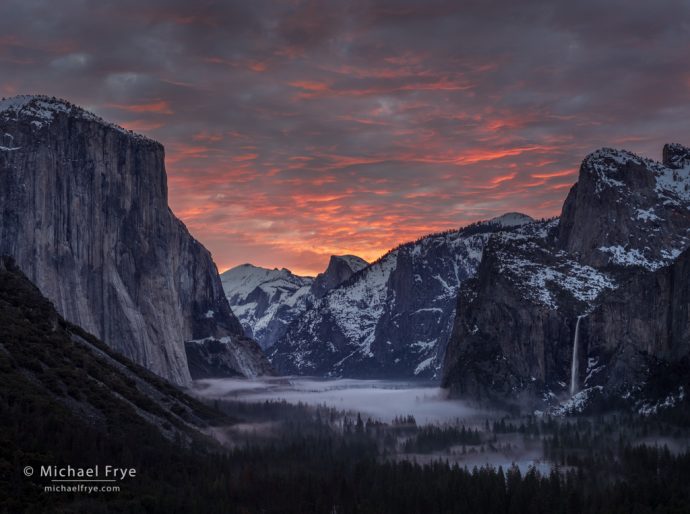
Sunrise from Tunnel View, Yosemite. On this morning the satellite images showed lots of high clouds, but I hoped there might be a gap to the east, allowing the sun to shine through and light the underside of the clouds. And I hoped for mist on the valley floor. That was asking for a lot, but sometimes things work out. The color lasted about three minutes. 50mm, three bracketed exposures, two stops apart, blended with Lightroom’s HDR Merge.
While early February brought lots of snow to Yosemite Valley, over the last three weeks we’ve seen a series of warmer storms, with rain rather than snow. I’d rather have snow, of course, but any weather is more interesting than blue skies. And rain on top of snow is a great mist producer.
Fog or clouds form when the temperature and dew point converge. That means either cooling the air to meet the dew point (like when air rises, and cools, and the water vapor in the air condenses into clouds), or raising the dew point to meet the air temperature (by increasing the amount of moisture in the air).
(more…)
by Michael Frye | Feb 20, 2019 | Light and Weather
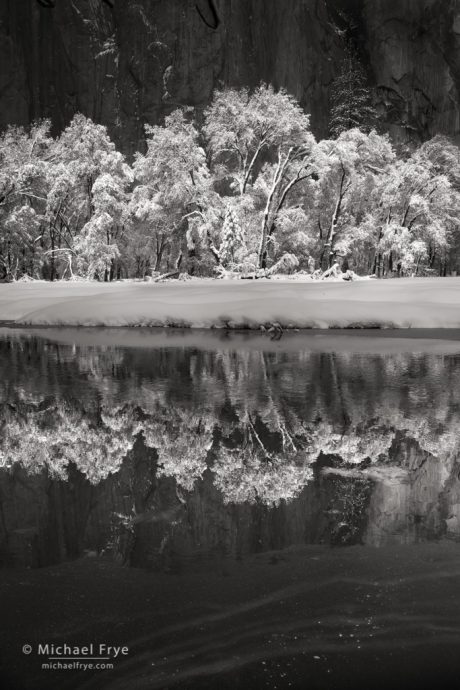
Snow-covered oaks reflected in the Merced River, Yosemite NP, CA, USA
On that snowy day I wrote about in my previous post the sun came out quickly, so our first stop was a spot near El Capitan that was still in the shade. I was looking for reflections, but then the sun hit the oaks across the river, while a cloud threw shade over El Cap, creating a beautiful contrast between the bright white trees and the dark cliff behind them.
The snowbank below the oaks, however, was really bright and distracting. All I need, I thought, is for a cloud to shade that snowbank while the sun was still hitting the trees. And a minute later it happened, setting up a dark-light-dark-light pattern. (That’s the image at the top of this post.)
(more…)
by Michael Frye | Feb 13, 2019 | Light and Weather
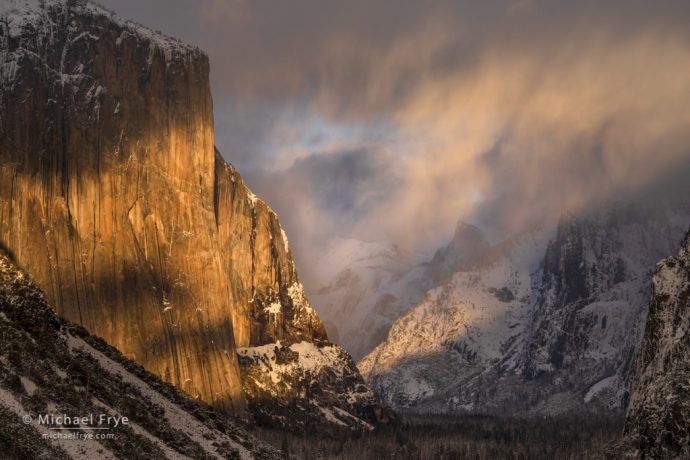
Stormy skies over the valley, Yosemite, Sunday evening
We’ve had one storm after another here in the Sierra Nevada. Two more storms came through this past weekend, back to back. They were cold systems, so it snowed in Yosemite Valley, with about five inches on Friday night, and another eight or nine inches on Saturday night and Sunday morning – all on top of at least 18 inches left over from the previous series of storms. The valley was quite a snowy place.
I kept checking the weather last weekend to see whether there might be a break between the first and second storms. All signs pointed to a partial break late on Saturday morning, but there seemed to be a slight chance that the storm might clear closer to sunrise on Saturday, so I drove up early – only to wait as a shower rolled in and dumped heavy snow for an hour.
(more…)
by Michael Frye | Feb 7, 2019 | Light and Weather
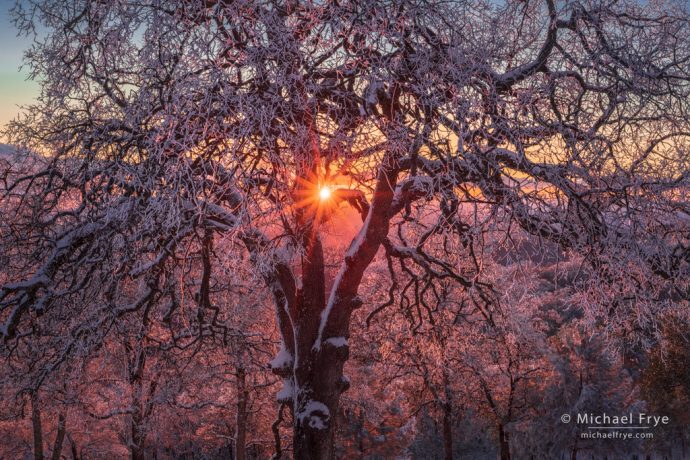
Ice-coated oaks at sunset, Mariposa County, CA, USA
California got hit by a big storm. It was actually a series of storms that started last Friday and ended late Tuesday, but it felt like one long storm because there was little break between the systems. We didn’t see the sun in Mariposa from Friday until Tuesday.
Yosemite Valley received 8 1/2 inches of precipitation (rain and snow equivalent) since Friday. That’s the largest amount I remember seeing over such a short period. (There was probably more rain during the ’97 flood, but I didn’t pay attention to the rain totals then).
(more…)
by Michael Frye | Feb 4, 2019 | Travels and Stories
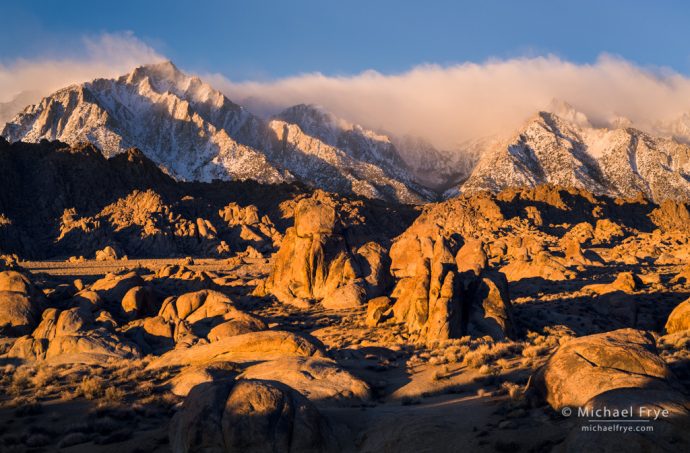
Early-morning light on Lone Pine Peak and the Alabama Hills, CA, USA
Claudia and I drive over to the eastern Sierra frequently in summer and fall, when Tioga Pass is open. We love it over there. But in the winter and spring Tioga Pass is usually closed, turning a two-and-a-half hour drive into an eight-hour drive. Until recently I had never been to Mono Lake in winter except during a couple of exceptionally-dry years when the pass stayed open later than usual – which hardly seemed like winter.
Our trip to photograph the lunar eclipse gave us an opportunity to do something we had always wanted to do: visit the east side in real winter conditions. I photographed sunrise at the Alabama Hills on Sunday morning before the eclipse, and then again on Monday morning, after the eclipse, as a storm was clearing over the Sierra.
(more…)
by Michael Frye | Jan 27, 2019 | Night Photography, Travels and Stories
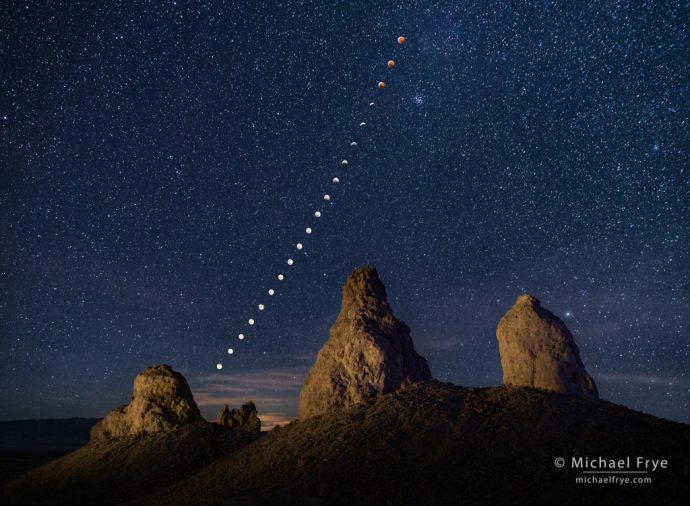
Lunar eclipse sequence, Trona Pinnacles, CA, USA, January 20th, 2019
The weather forecasts prior to last Sunday’s lunar eclipse showed lots of clouds over the western U.S. Lots of clouds. On Thursday before the eclipse it looked like we might possibly find clear skies in southern Arizona, or around Death Valley, but the chances for either location looked slim.
By Saturday it appeared that southern Arizona would probably be covered in clouds at eclipse time. Yet computer models for the evening of the eclipse kept showing a small slot of clear sky extending from about Lancaster, California (in the desert north of Los Angeles) northeast through the Trona Pinnacles, Death Valley, and continuing into Nevada and Utah. I couldn’t think of anything in Nevada to use as a foreground, but Death Valley or the Trona Pinnacles could certainly work.
(more…)
by Michael Frye | Jan 24, 2019 | Travels and Stories
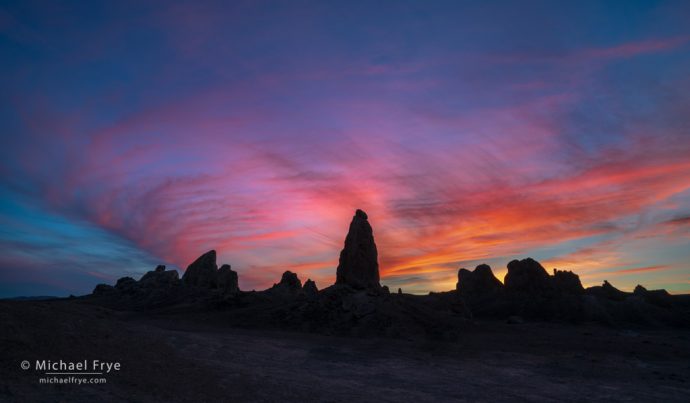
Sunset, Trona Pinnacles, CA, USA
Claudia and I just got back from a short road trip to the eastern Sierra and Trona Pinnacles. We ended up at Trona for the lunar eclipse on Sunday evening, as the forecasts indicated that would be one of the few places west of the Rockies with clear skies.
(more…)


















